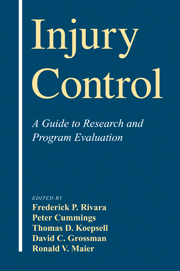Book contents
- Frontmatter
- Contents
- List of Contributors
- 1 An Overview of Injury Research
- 2 Classifying and Counting Injury
- 3 Measurement of Injury Severity and Co-morbidity
- 4 Data Linkages and Using Administrative and Secondary Databases
- 5 Rates, Rate Denominators, and Rate Comparisons
- 6 Data Collection Methods
- 7 Selecting a Study Design for Injury Research
- 8 Qualitative Methods in Injury Research
- 9 Randomized Trials
- 10 Cohort Studies in Injury Research
- 11 Case–Control Studies in Injury Research
- 12 Ecologic Studies
- 13 Case Series and Trauma Registries
- 14 Systematic Reviews of Injury Studies
- 15 Evaluating an Injury Intervention or Program
- 16 The Development of Clinical Decision Rules for Injury Care
- 17 Trauma Performance Improvement
- 18 Measuring Disability and Quality of Life Postinjury
- 19 Economic Evaluation of Injury Control
- 20 Ethical Issues
- Index
3 - Measurement of Injury Severity and Co-morbidity
Published online by Cambridge University Press: 16 October 2009
- Frontmatter
- Contents
- List of Contributors
- 1 An Overview of Injury Research
- 2 Classifying and Counting Injury
- 3 Measurement of Injury Severity and Co-morbidity
- 4 Data Linkages and Using Administrative and Secondary Databases
- 5 Rates, Rate Denominators, and Rate Comparisons
- 6 Data Collection Methods
- 7 Selecting a Study Design for Injury Research
- 8 Qualitative Methods in Injury Research
- 9 Randomized Trials
- 10 Cohort Studies in Injury Research
- 11 Case–Control Studies in Injury Research
- 12 Ecologic Studies
- 13 Case Series and Trauma Registries
- 14 Systematic Reviews of Injury Studies
- 15 Evaluating an Injury Intervention or Program
- 16 The Development of Clinical Decision Rules for Injury Care
- 17 Trauma Performance Improvement
- 18 Measuring Disability and Quality of Life Postinjury
- 19 Economic Evaluation of Injury Control
- 20 Ethical Issues
- Index
Summary
Introduction
The purpose and need for injury severity scoring systems has changed with time, as has the needs of investigators and clinicians. The earlist effort at standardizing injury severity scoring is generally credited to the Abbreviated Injury Scale (AIS) Score, a scoring system initially developed to categorize injury type and severity following motor vehicle crashes; its primary purpose was to support multidisciplinary crash investigation (Committee on Medical Aspects of Automotive Safety, 1971). However, the evolution of trauma care and trauma systems has led to a need for more comprehensive injury recording, and thus, subsequent revision of the AIS. In contrast, the Glasgow Coma Scale (GCS) score was developed in the mid-1970s as a method to categorize the severity of traumatic brain injury (TBI) and has remained essentially unchanged (Teasdale and Jennett, 1974; Jennett and Teasdale, 1976). Over time this score has remained useful in predicting outcome following TBI, has been incorporated into other scores for predicting outcome, and is considered a critical component in the evaluation of trauma care systems (Boyd et al., 1987). These two scores provide examples of how changing needs over time have resulted in either a change in the actual scoring system or an application of the scoring system to a broader range of uses. The main purpose of scoring systems, however, largely remains the same: to grade injury severity to allow for comparisons between individual patients or groups of patients.
The objectives of this chapter are to describe existing measures of injury severity, to review the rationale for their development, and to discuss their use and important limitations. In addition, measures of co-morbidity, the term used to describe health status factors likely to influence the outcome after injury, will be reviewed.
Keywords
- Type
- Chapter
- Information
- Injury ControlA Guide to Research and Program Evaluation, pp. 32 - 46Publisher: Cambridge University PressPrint publication year: 2000
- 1
- Cited by



